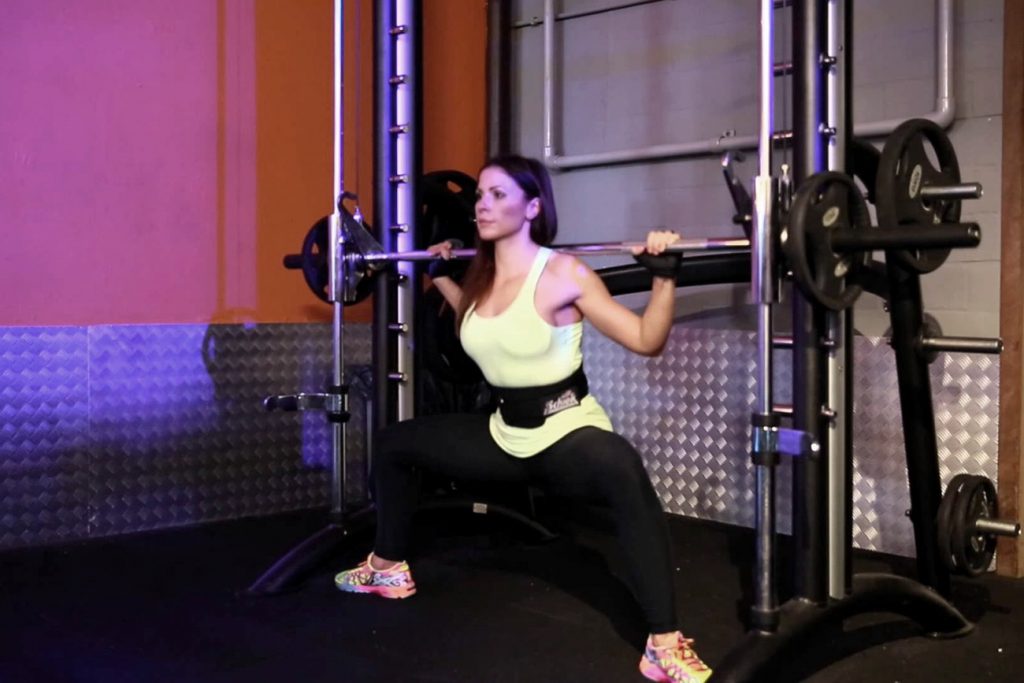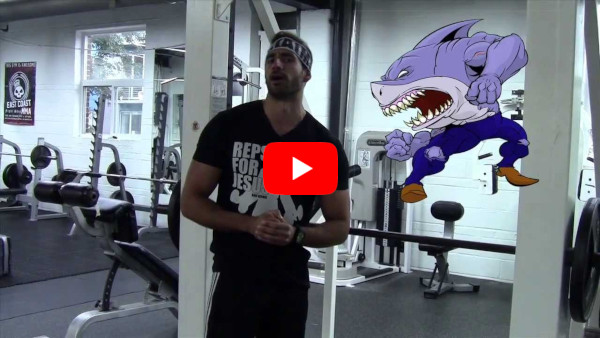The Smith Machine, despite being a much-maligned piece of gym equipment by many free weight purists, is in fact one of the most versatile and useful machines you’ll find anywhere in the gym.
Its detractors frown upon the fact that it constricts your movements to a single up and down direction, earning it a reputation among some of them as being strictly for novices.
Some even treat it as somewhat of a bad joke, as you can see from this video (foul language warning!):
OK, OK that’s very funny, I’ll admit.
But far from being some kind of novelty or kid’s toy, the fact is that the Smith Machine enables you to do a number of unique exercises, many of which simply can’t be done in any other way.
Below is a list of 14 Smith Machine exercises that you should consider making use of in your workout program. For each exercise I detail why performing it specifically using a Smith Machine is advantageous to doing it using any other piece of equipment.
Just because the Smith Machine offers certain benefits for a particular exercise over other equipment however, that’s not to say that the exercise should only ever be done on a Smith Machine. All types of equipment provide their own unique benefits, which can and should be taken advantage of in a well-rounded workout program.
1. Squats
Sure, squats are pretty simple, straightforward exercises that anyone can do very effectively with a barbell or dumbbells. But they have one restriction, and that is that you need to maintain your balance at all times. Not so on a Smith Machine.

When performing Smith Machine squats you virtually have an infinite number of options as far as foot placement goes, which allows you to target your quads and glutes in different ways and to different degrees without any regard for maintaining your balance.
For example, by placing your feet out in front of you, you can effectively perform a hack squat, with your torso remaining vertical and your lower legs remaining perpendicular to the ground. Place your feet further forward still and you isolate your quads even more so.
You can also choose foot positions that can minimize knee torque and knee shearing forces, to avoid experiencing too much discomfort squatting with any knee problems you might have. And of course while you can also perform Sumo squats on a Smith Machine, narrow stance squats are possible as well, without any danger of falling.
2. Single-Leg Squats
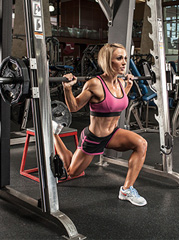
Single-leg squats are even more so dictated by balance, given the added risk of falling sideways. This makes them very dangerous to perform with a barbell. On a Smith Machine however, once again balance is not an issue and so these can be performed very safely.
The same observations about foot placement as those made above also apply to single-leg squats, including Bulgarian split squats – you can vary your foot position to emphasize your quad or glute differently.
An added benefit of single-leg squats performed as Smith Machine exercises is that you can you can locate your supporting foot across the centerline of your body to hit your glute at an oblique angle, making it a variation of a curtsy squat.
3. Deep Squats
One of the factors limiting the depth you can squat to for a deep squat is your ankle flexibility. You reach a point where you can’t go any lower (without lifting your heels off the ground) because your ankles don’t allow any more forward rotation of your shins to maintain balance.
Once again, with Smith Machine exercises balance is not an issue. Squatting on the Smith Machine will allow you to squat as deep as you like while keeping your feet flat on the ground, without any possibility of toppling backwards.
4. Calf Raises
If your gym doesn’t have a standing calf raise machine then a Smith Machine is the perfect alternative. The benefit over using a barbell is that you can focus completely on working your calves without having to worry about maintaining your balance.
Place a couple of weight plates under the front half of each foot to allow your ankles to go into full dorsi flexion (foot flexed upward) so that you work the entire range of motion.
5. Cleans
When performing power cleans an important point is to lift the bar vertically in a straight line up to the catch position at the top. When cleaning a very heavy bar this is a necessity, since it will be too heavy to lift through a curved path. When practicing the movement with a lighter bar however, it’s easy to develop bad habits and not lift the bar completely vertically.
By practicing your full cleans and hang cleans (starting with the bar hanging in front of your thighs with your knees slightly bent) on a Smith Machine, you ensure that you lift the bar vertically each time before progressing to heavier weights, therefore developing good form safely.
6. Donkey Kicks
Donkey Kicks are great Smith Machine exercises that target your glutes. If your gym doesn’t have a Butt Blaster machine, then Donkey Kicks on the Smith Machine are a perfect alternative.
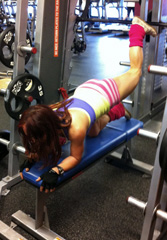
To perform these place a bench inside the Smith Machine, and position yourself on the bench on your hands and knees. Extend one leg back so that you raise the bar with your foot, and keep raising it until your leg reaches its full extension. After completing the set repeat the exercise with your other leg.
With Donkey Kicks you can change around the bench placement so that it’s closer to the bar and you’re extending your leg in quite a vertical orientation, or further from the bar so that you’re extending it away and up (as shown in the photo). You should make use of both variants to hit your glutes in different ways.
7. Bent-Over Row
One of the great benefits of performing bent-over rows on the Smith Machine is that it forces you to lift the bar vertically. This is particularly important when using an underhand grip. So often when I see people in the gym performing this exercise they execute both a row and a bicep curl at the same time as they raise the bar.
By involving the biceps in the movement in this way, it causes two problems. Firstly, it actually makes the movement easier on your lats since curling the bar causes the horizontal distance between it and the pivot point (your shoulders) to shorten. And secondly, by raising the bar some of the way using a curl, it reduces the range of motion over which the lats are worked.
Another common mistake with this exercise, when using both an overhand and underhand grip, is standing too upright. This is what often happens when using too much weight. Ideally your body should be horizontal to 30 degrees above horizontal, no more than that. Keep your feet about shoulder width apart, knees slightly bent, and your spine neutral.
8. Rack Chins
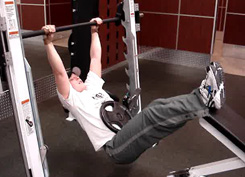
Rack Chins are another awesome exercise for the lats, and because they require a horizontal bar positioned at about chest height, they make an ideal exercise to perform on a Smith Machine.
These are performed much like an overhand pull-up, the only difference being that rather than your body hanging vertically, it instead hangs in an L-shape with your feet propped up on a step or a bench. This is shown in the accompanying photo.
To add further resistance to this exercise you can position some additional weight in your lap in the form of a weight plate, a dumbbell, a short barbell, or perhaps best of all, a short EZ-curl bar, which won’t have a tendency to roll along your legs. You may need the help of an assistant however to position the weight for you.
9. Bench Press
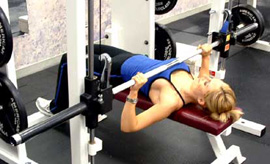
The common bench press is another exercise that can benefit from what so many other Smith Machine exercises benefit from, and that is inherent stability.
With the guidance of a Smith Machine, you’ll find that you should be able to press more weight than is possible with a simple barbell, because the machine takes care of the stabilization of the weight for you. This is ideal for subjecting your pectorals to greater resistance, therefore helping to improve their hypertrophy (growth) and strength.
Another benefit of doing the bench press on a Smith Machine is it makes the exercise much safer if you’re working without a spotter.
If you’d like to read more about Smith Machine bench press benefits, click here.
As I mentioned earlier however, this doesn’t mean that bench presses should always be done on a Smith Machine. Instead, Smith Machine bench presses should be incorporated into your program as an addition that provides this unique benefit.
As with barbell bench presses, these can also be done on an incline or decline bench.
10. Shoulder Press
As for the bench press, the seated barbell shoulder press can also benefit from the use of a Smith Machine to provide stability, making it possible to press greater weight. This in turn provides the same benefits mentioned above for the bench press.
Generally speaking, a wider grip will focus more on your lateral deltoids, while a narrower grip will focus more on your anterior (front) deltoids.
11. Rear Delt Row
While performing a bent-over rear delt row on a Smith Machine provides no real benefit over simply using a barbell, on a Smith Machine you have the option of performing them inverted as a body weight exercise, just for something different.
The usefulness of the Smith Machine here is in its ability to have its bar set at any convenient height, as is the case for Rack Chins.
12. Biceps Curls
As for the rear delt row, simple bicep curls can be performed inverted on a Smith Machine as a body weight exercises, just to add an additional variant to your repertoire of exercises. By varying the bar height and therefore the angle of your body, you can also alter the difficulty of the exercise.
13. Close-Grip Triceps Press

The close-grip triceps press is a variant of the bench press where your hands are positioned closer on the bar (shoulder width apart or less) and arms oriented alongside your body rather than out to the sides. This causes the triceps to be targeted rather than the pectorals (chest muscles).
As for the bench press, performing this exercise on the Smith Machine provides the benefit of added stability so that you can target your triceps more acutely without the engaging of stabilizer muscles around your shoulders.
This exercise can also be done using an incline or decline bench, and additionally, by locating the bar over the top of your head or even higher rather than over your shoulders, you make it a constant tension exercise since your triceps will still be engaged at the top of the movement.
14. Plyometrics
Plyometrics are a type of exercise rather than a specific exercise, and they involve rapid, explosive power movements. Plyometric Smith Machine exercises rely on the guidance of the machine to make them relatively safe to perform.
Exercises that are suited to being done plyometrically on the Smith Machine are pushing movements. The bench press and the shoulder press are perfect examples.
To perform these, rather than raising the bar in a controlled manner it’s instead thrust upwards powerfully so that at the top of the movement it disengages from your hands and is “thrown” several inches into the air. You then catch the bar as it comes back down before completing the eccentric (lowering) phase of the exercise.
Some people frown upon this practice as being unsafe. There is only a very remote chance of you failing to catch the bar however, although you should judge for yourself whether you feel comfortable that you can safely perform this type of exercise on the Smith Machine.
As you can see then, the Smith Machine is indeed a very versatile and useful piece of equipment that has a valuable place in any workout program.
The exercises I’ve mentioned here cannot be performed in any other way that provides the same benefits as the Smith Machine, with the possible exception of specialized weight machines in some cases.
In addition to these however, there are a number of other exercises that can also be done on a Smith Machine, albeit without any specific benefits over free weights or other equipment, but just for convenience.
Some examples of these include:
- Upright rows
- Shrugs
- Bicep Drag Curls
- Triceps Dips
- Hanging Knee/Leg Raises
- Push Crunches
- Seated Calf Raises
- Stiff-Legged Deadlifts
All in all, there really is no muscle group that can’t be targeted specifically using Smith Machine exercises. It’s literally possible to do an entire full-body resistance workout on the Smith Machine alone.
Are there any of these or other exercises that you like to perform on the Smith Machine on a regular basis? Perhaps you’ve even developed some of your own. I’d love to hear your feedback in the comments below!


